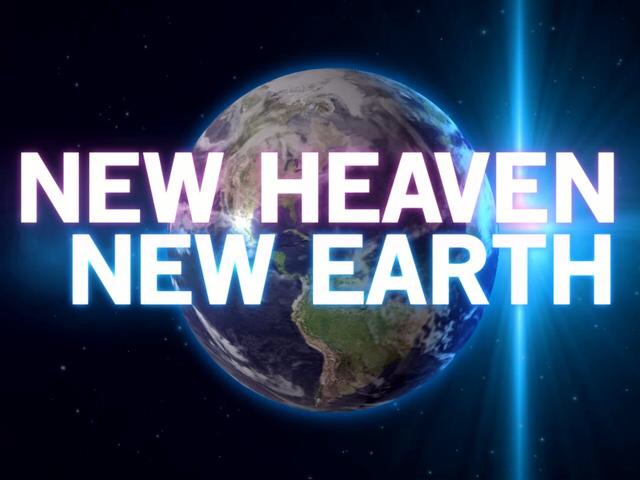Literal New Heaven and New Earth?! By Jonathan Welton
I have grown up most of my life believing that Revelation 21-22 is about a literal future place known as the New Heaven and the New Earth. It was only in the last 5 years that I began to go through a massive shift in my understanding.
I have come to the place in my study of the Bible that I always aim to use a Historical Contextual Hermeneutic, which means that I try to understand what the first readers of the Bible would have understood. This is the opposite of how many modern readers impose their modern understanding upon the text. Many do not put themselves into the shoes of the first century reader and thus they end up being extremely literal when they read passages that are meant to be figures of speech.
So what did the first century reader understand a New Heaven and New Earth to be? Was it a figure of speech or something that we should take literally?
Let’s start with the basic understanding of “heaven and earth” in the first century.
Jesus says in Matthew 5:18 “For truly I tell you, until heaven and earth disappear, not the smallest letter, not the least stroke of a pen, will by any means disappear from the Law until everything is accomplished.”
We have likely read over this passage many times and not thought through the implications of this verse. It gives us a choice between two options.
Heaven and earth exist = 100% of the Law is still in force
Heaven and earth disappear = the Law can disappear
So then, if we understand heaven and earth to be the literal physical earth, then 100% of the Mosaic Old Covenant Law is still in force until the end of this planet. Including the Temple sacrifices and the 3 annual pilgrimages to Jerusalem, etc. Not one Jot or Tittle has passed.
Or could Jesus be using a figure of speech that everyone in the first century understood?
Either Jesus was talking about something else or the Law is 100% in effect currently, until the planet is destroyed.
We gain another clue the next time Jesus mentions heaven and earth in Matthew 24:35 “Heaven and earth will pass away, but My words will not pass away.”
As you know, Matthew 24 is about the destruction of the temple in the first century. Yet Jesus throws this comment in there. Why? Because the first century people referred to the temple system as “heaven and earth.”
Sources as early as Josephus extrapolate that the very design was after the design of heaven and earth:
…for if any one do but consider the fabric of the tabernacle, and take a view of the garments of the high priest, and of those vessels which we make use of in our sacred ministration, he will find that our legislator was a divine man, and that we are unjustly reproached by others; for if any one do without prejudice, and with judgment, look upon these things, he will find they were everyone made in way of imitation and representation of the universe. When Moses distinguished the tabernacle into three parts, and allowed two of them to the priests, as a place accessible and common, he denoted the land and the seas, these being of general access to all; but he set apart the third division for God, because heaven is inaccessible to men. And when he ordered twelve loaves to be set on the table, he denoted the year, as distinguished into so many months. By branching out the candlestick into seventy parts, he secretly intimated the Decani, or seventy divisions of the planets; and as to the seven lamps upon the candlesticks, they referred to the course of the planets, of which that is the number. The veils, too, which were composed of four things, they declared the four elements; for the fine linen was proper to signify the earth, because the flax grows out of the earth; the purple signified the seas, because that color is dyed by the blood of a seas shell-fish; the blue is fit to signify the air; and the scarlet will naturally be an indication of fire. Now the vestment of the high priest being made of linen, signified the earth; the blue denoted the sky, being like lightning in its pomegranates, and in the noise of the bells resembling thunder. And for the ephod, it showed that God had made the universe of four elements; and as for the gold interwoven, I suppose it related to the splendor by which all things are enlightened. He also appointed the breastplate to be placed in the middle of the ephod, to resemble the earth, for that has the very middle place of the world. And the girdle which encompassed the high priest round, signified the ocean, for that goes round about and includes the universe. Each of the sardonyxes declares to us the sun and moon; those, I mean, that were in the nature of buttons on the high priest’s shoulders. And for the twelve stones, whether we understand by them the months, or whether we understand the like number of the signs of that circle which the Greeks call the Zodiac, we shall not be mistaken in their meaning. And for the mitre, which was of a blue color, it seems to me to mean heaven; for how otherwise could the name of God be inscribed upon it? That it was also illustrated with a crown, and that of gold also, is because of that splendor with which God is pleased. Let this explication suffice at present, since the course of my narration will often, and on many occasions, afford me the opportunity of enlarging upon the virtue of our legislator.
– Josephus
John Lightfoot (1602-1675), the highly respected author of the four volume series, A Commentary on the New Testament from the Talmud and Hebraica, observed how heaven and earth is used in the New Testament: the “passing away of heaven and earth” is the “destruction of Jerusalem and the whole Jewish state…as if the whole frame of this world were to be dissolved.”
Maimonides also observed in the 12th century that:
The Arabs likewise [as the Hebrew prophets] say of a person who has met with a serious accident, “His heavens, together with his earth, have been covered”; and when they speak of the approach of a nation’s prosperity, they say, “The light of the sun and moon has increased,” A new heaven and a new earth has been created,” or they use similar phrases.
And lastly for good measure, consider Charles Spurgeon’s words:
Did you ever regret the absence of the burnt-offering, or the red heifer, or any one of the sacrifices and rites of the Jews? Did you ever pine for the feast of tabernacles, or the dedication? No, because, though these were like the old heavens and earth to the Jewish believers, they have passed away, and we now live under new heavens and a new earth, so far as the dispensation of the divine teaching is concerned. The substance is come, and the shadow has gone: and we do not remember it.
So then what am I saying about Revelation 21-22?
Many Christians see the Book of Revelation as an orderly sequence of events, which finalizes at the end of human history in chapters 21-22 with a New Heaven and New Earth. Yet the text itself proves this view to be flawed.
If Revelation 21-22 is the picture of the final perfect order of the future world after the Final Judgment and return of Jesus, then what about the following imperfections:
- How are there evil people existing just outside the gates of the city?
14 “Blessed are those who wash their robes, that they may have the right to the tree of life and may go through the gates into the city. 15 Outside are the dogs, those who practice magic arts, the sexually immoral, the murderers, the idolaters and everyone who loves and practices falsehood. – Rev 22:14-15
- The leaves are for the healing of the nations, but wouldn’t the nations already be healed?
“On each side of the river stood the tree of life, bearing twelve crops of fruit, yielding its fruit every month. And the leaves of the tree are for the healing of the nations.” – Rev 22:2
- How are there still nations and monarchies existing outside the city?
“The nations will walk by its light, and the kings of the earth will bring their splendor into it.” – Rev 21:24
Are we to take this literally and suppose that the city will actually extend 1400 miles above the surface of the earth?
16 The city was laid out like a square, as long as it was wide. He measured the city with the rod and found it to be 12,000 stadia [approx. 1400 miles] in length, and as wide and high* as it is long. – Rev 21:16
*(Currently the world’s tallest building stands at 2,722 ft, which is .5 miles tall. Planes fly in the Jetstream at 6-7 miles high, and Outer space begins at 62 miles. The New Jerusalem will supposedly extend 1338 miles into Outer space…if we are to be so literal.)
Clearly to take New Heavens and New Earth in a literal wooden fashion is akin to believing in childish fantasies such as Santa Claus and the Tooth fairy. Jesus and the Apostles of the first century were simply using the cultural vernacular of the day when they referred to the Old Covenant Temple system being destroyed by fire as the “heavens and the earth passing away” and the New Covenant System taking its place as the “New Heavens and the New Earth.”
Revelation 21-22 is not about the end of human history. Obviously the work is not completed in those chapters and Jesus is “making all things new” still (Rev. 21:5). The picture that John is drawing is the same picture that he draws throughout the entire book, a New Covenant world has arrived and we must get to work.




Wow…. the more I learn about what the Bible is really saying, the more I realize how free I am, how loved I am, how victorious I am! Thank You, Jesus Christ!
Good Stuff here!
Very nice, Jonathan. In the last 150 years dominated by the wooden literalism of dispensationalism, it seems that at least in terms of biblical literacy, we have regressed. Lightfoot, Brown and Spurgeon were light years ahead of most of us in their understanding of the most rudimentary concepts of hermeneutics. Thanks for your dedication to elucidate the truth, even as you are probably castigated for it.
This is very very interesting
The coming of the New Heaven and New Earth is a global awakening to the reality of God. It is a sudden realization informed by a new wave of information. All of mankind will be transformed by the new information as though we have changed from old people to a new people.